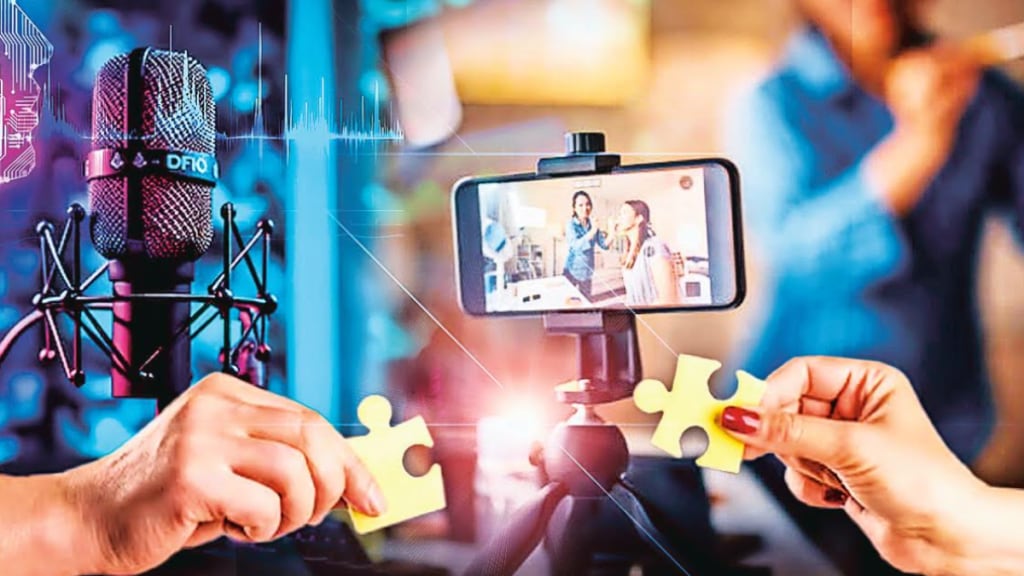Three trends stood out in the year passing us by: Social media influencers became mainstream brand ambassadors, agency consolidation picked up pace and the audio medium seemed to find its place in the sun
Oindrila Roy
When influencers became mainstream…
over the years, influencer marketing has evolved from a mere marketing tactic to a strategic tool that delivers measurable business results. The valuation of the influencer marketing industry has surged from $6.5 billion in 2019 to a staggering $25.4 billion in 2024, as brands recognise the powerful impact influencers can have on revenue. India alone is estimated to be worth `5,000-5,500 crore. By 2028, globally, a significant 80% of brands are expected to allocate 30% of their marketing budgets to influencer marketing.
In 2024, digital-first brands forged long-term partnerships with influencers to produce high-quality, social-first content, making influencers integral to their content strategies. These collaborations result in cost-effective, high-quality content produced at unprecedented speeds, enabling brands to react swiftly to emerging trends and leverage user-generated content. Research confirms that creator-produced content resonates better with both modern marketers and audiences due to its authenticity, agility, and overall effectiveness.
This trend has also led to the rise of nano influencers who cater to niche audiences and are perceived as more authentic. As they have small but highly engaged audiences, content created by nano influencers typically leads to higher click-through rates and conversions. The highly targeted approach that nano influencers bring results in better ROI, making them increasingly popular among marketers.
Another trend to watch is the rise of influencers targeting rural India. With the evolving digital landscape, vernacular digital influencers are becoming increasingly important for social and economic change. By creating culturally relevant content in familiar dialects, these influencers forge deeper connections with their audiences.
Today, influencers are not just sharing trends but driving real business impact. By embracing creativity, innovation, and data-driven insights, the future of influencer marketing in India looks brighter than ever. As the industry matures, we can expect even more exciting developments and groundbreaking campaigns in the years to come.
The author is managing director, Publicis India
Krishna Iyer
When consolidation became the way to grow…
The advertising landscape underscores a strategic shift: consolidation and collaboration are no longer optional—they are central to thriving in an evolving marketplace. This movement reflects the intersection of client demands, technological advancements, and the need for streamlined operational efficiency.
Clients are steering the consolidation trend, prioritising end-to-end solutions that reduce the complexity of managing multiple agencies. They demand cohesive, integrated campaigns that cut through the clutter.
For example, Unilever’s decision to consolidate its media and creative accounts under fewer networks, like WPP, IPG, and Omnicom, exemplifies this. By minimis-ing the number of agency partners, Unilever has achieved faster turnarounds and campaigns where the synergy between strategy, media, and creative amplifies impact.
Shrinking marketing budgets and the complexity of multi-channel campaigns have necessitated agile, matrixed structures. Integrated teams combining creative, media, technology, and strategy offer the flexibility and innovation that today’s brands demand. Google, Meta, and other tech giants are no longer just media platforms—they are full-service competitors offering creative, data, and media solutions. For agencies, this is a wake-up call: no single entity can do it all. Collaboration is the only path to remain relevant.
Recently for instance, within one client, there were multiple agencies offering different services but catering to one campaign brief. As a lead agency, we took on the responsibility to orchestrate
the entire campaign with 12 different partners.
WPP’s bespoke “OpenX” team for Coca-Cola is a prime example of consolidation in action bringing together talent across disciplines to deliver cohesive, data-backed global marketing, illustrating the effectiveness of breaking down silos. Similarly, GroupM’s merger of Essence and MediaCom created a robust entity capable of leveraging scale and data insights, redefining efficiency in media planning.
The author is director, marketing, MullenLowe Lintas Group
Abe Thomas
When technology transformed a medium…
2024 surely was a defining year for the radio industry as it leveraged technological innovations like never before transforming into a vibrant, multi-media platform, taking its radio plus proposition a notch higher. AI became an indispensable part of the industry, being incorporated across key functions such as copywriting and ad creation to remastering recordings and enhancing audio quality. Gamification, influencer marketing and AI driven interactions too were explored in formulating business strategies.
The radio industry is increasingly driven by technology to improve content creation, analytics, targeting and consumer experience. The proliferation of interactive formats such as e-commerce and social commerce is further helping enhance consumer engagement.
In the coming year, the groundwork laid in 2024 will only propel the industry to push the envelope . With the imminent launch of digital radio, the medium will be able to curate playlists that resonate on an individual level, enabling real-time interactions, making radio more immersive, intuitive and alive. In parallel, advertisers will harness AI to execute hyper-targeted campaigns, maximising return on investment.
The author is CEO, BIG FM

